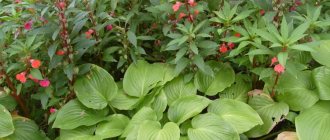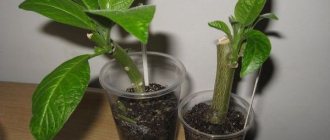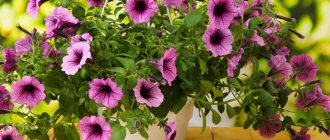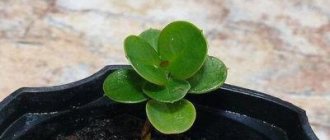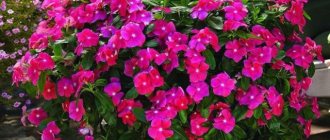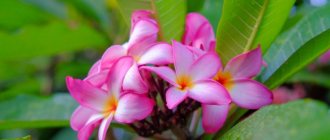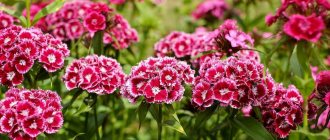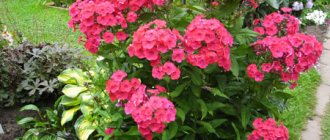Impatiens is a widespread ornamental plant in our country and throughout the world. The culture is famous for its pleasant-looking flowers of various colors, resistance to disease, and unpretentiousness to living conditions. The most common practice is to grow balsam from seeds at home.
- 2 When to plant
2.1 General planting dates - 2.2 Lucky dates according to the lunar calendar
Features of balsams
Indoor balsam
The flower belongs to the genus Balsaminaceae and is part of a larger family of the same name. Its name, translated from ancient Latin, means “sensitive, not liking pressure.” Because of its delicate stems, balsam is called impatiens. And the property of ripe fruits to scatter seeds at the slightest touch gave the flower another apt name “jumper”. But that is not all. “Vanka is wet” - due to moisture on the leaves, which can release it after watering. “Vanka-Vstanka” - for the ability to grow upward, no matter how the pot stands. “Spark” - for the flaming shade of the petals. “Beautiful Wreath” is an Austrian name. In England, the constantly flowering plant is called "Business Lizzie", in Germany - "Eager Lizzie".
Africa is considered the birthplace of balsams. The flower also grows in Central Asia. In the temperate climate of European countries, the exotic beauty began to be grown several centuries ago. The Portuguese brought this cozy plant with lush flowers.
Impatiens can be grown as annuals or perennials. In autumn, after flowering in open ground, they are removed. Flowers have a delicate root system that does not tolerate winter cold. Only part of the seeds that fall into the ground by self-sowing can easily withstand frost and sprout next spring. Perennial flowers are grown at home. If all requirements are correctly met (and they are quite simple), impatiens bloom all year round.
Terry balsam
Externally, all varieties of balsams are similar. These are herbaceous plants with fragile succulent stems. According to their growth form, they can be bushy, erect or hanging . The height ranges from 20 cm (Tom Tamb balsam) to 1 m (Balfour's balsam). The leaves of the plant are oval-heart-shaped, their color varies depending on the variety: from green to burgundy or variegated. Balsams are bred for their lush flowering. The flowers are single or collected in inflorescences, the shades come in a variety of colors. Among the popular varieties are balsams with double buds. Later, fruit boxes form in place of the flowers.
Today, over 500 types of balsams are known, a large number of varieties and hybrids, allowing you to choose the right plant based on height, bush shape, leaf and flower color, and bud size.
New Guinea balsam
Among the most popular varieties, Waller's balsam stands out, perfect for both garden and home cultivation. The latest “acquisition” of gardeners is New Guinea balsam, a beautiful, unpretentious and hardy plant.
Dates for sowing balsam seedlings in 2022
When is the best time to sow balsam seeds for seedlings in 2022? It is better to plant flower crops in the second half of March and early April . This time is relevant for all varieties and types of garden plants (Waller, Tom Thumb, New Guinea and others), including hanging ones.
However, due to different weather and climatic conditions, sowing dates may vary: in the South you can plant in the middle or even at the beginning of March, in the middle zone (including the Moscow region) it is optimal to plant at the end of March, in Siberia, the Urals, In the Leningrad region it is better to sow in early April.
The timing of planting garden balsam can also be determined according to the Lunar calendar of 2022:
- Favorable days: in January: 1, 10, 11, 15, 16, 19, 20;
- in February: 7, 8, 12, 13, 14, 15;
- in March: 10, 11, 15, 20, 21, 24, 25.
- Unfavorable days: in January: 2, 18th;
- in February: 1, 16;
- in March: 2, 16, 17, 18, 31.
Growing conditions
Planted cuttings of a hybrid variety of balsam
Impatiens propagate in two ways: cuttings and seeds . The first method is simpler and allows you to grow an individual with maternal properties. The second option is more complex and interesting, and by crossing two plants you can get a flower with original characteristics.
For experienced gardeners, growing balsams is not difficult. Those who are just starting to grow house plants need to familiarize themselves with the conditions for their cultivation and the necessary rules of care. And here are complete instructions for growing balsams from seeds.
Seed selection
Balsam seeds
To ensure that the work of growing balsam from seeds at home is not in vain, you need to take a responsible approach to the choice of seed material.
Points to pay attention to:
- Best before date . Balsam seeds have a long germination period - 7–8 years. All information about a specific planting material can be read on the bag. The collection date is also indicated there, which will give an idea of the freshness of the seeds.
- Annual or perennial . Impatiens are perennial plants. But in open ground they are grown as annuals, because the plant's delicate roots do not tolerate cold. In the fall, before frost, the plants are removed. To admire the flower for more than one year, it is grown at home.
- Mixture or variety . If the word “mixture” is indicated on the bag, then it is not yet known what color of flowers you will get. Therefore, if you want to grow a specific balsam with the desired properties, you purchase a specific variety.
- Hybrids . Many of these plants bloom well at home and easily tolerate indoor seasonal dryness. But they practically do not form seeds. Therefore, such varieties are propagated by cuttings. It will not be possible to repeat a hybrid variety using seeds.
Purchased balsam seeds
Experienced gardeners know that they need to buy seeds in trusted specialized stores; preference is given to products from a reliable manufacturer. It is not recommended to purchase balsam sachets on sales or in large retail chains . The probability of getting absolutely the wrong plant is too high. And the germination of such seeds is a big question.
Checking seed germination
Some sources also indicate this method of testing seeds for germination: they should be placed in a bowl of room water. They say that good seeds will sink to the bottom, bad ones or “dummies” will float to the surface. But this test is used mainly on freshly harvested seeds. Purchased planting material will not show accurate results.
Landing dates
Homemade balsam blooms all year round. And the timing of planting young plants usually does not matter. But if you want to show off young flowering bushes at some point, then you need to plant the seeds 3-4 months before the appointed time. On warm summer days, you can decorate your balcony or loggia with flowers. Then the crops are sown in February - March.
Disinfection of seeds in potassium permanganate
But even before planting, the seed should be disinfected. This will provide an additional guarantee that accidentally infected seeds will not spread the disease to all seedlings. For disinfection, prepare a weakly saturated solution of potassium permanganate and dip a gauze bag with seeds into it for 20 minutes. Next, everything is washed under running water and left to dry for a short time if planting is planned for another day.
Soil requirement
Ready-made soil mixture
Young seedlings, which are more sensitive to the environment, require specific soil. When growing balsam from seeds, you need light, slightly acidic, moderately nutritious soil. Too fertilized soil will lead to deficient balsam flowering. They will grow stems and leaves, but have difficulty opening buds.
The easiest way is to buy soil in a specialized store. Impatiens are not too picky; ordinary soil for flowering indoor plants is also suitable.
Experienced gardeners make up their own soil mixture. For example, one of her recipes might include the following ingredients:
- turf soil - 2 parts;
- soil with foliage - 2 parts;
- humus - 2 parts;
- sand - 2 parts;
- peat - 1 part.
Some make it simpler: they make up a substrate of peat and vermiculite (perlite) in a 1:1 ratio. The second component of the soil helps regulate moisture and protects the plant roots from rot.
Disinfection of soil in the oven
The prepared soil is calcined in the oven to destroy harmful microorganisms. It would also be useful to treat the soil with fungicides - chemical or biological preparations that prevent flowers from becoming infected with fungal diseases.
Soil preparation
Universal soil intended for growing garden seedlings is not suitable for balsam. The soil should be light and loose, moisture- and breathable, not oversaturated with humus, and neutral.
Ideal composition:
- turf land;
- peat;
- perlite;
- sand.
All components must be thoroughly mixed, sifted and disinfected by pouring boiling water on them or calcining them in the oven.
Exotics are nearby: 10 not quite ordinary plants that you can plant in your garden
Sowing seeds
Preparing pots for planting seeds
Containers for seedlings are prepared in advance. These can be boxes, containers or pots slightly more than 7 cm high. Drainage holes are a prerequisite. A layer of expanded clay (1/5 of the height of the pot) is placed on the bottom of the prepared container, and the prepared soil is poured on top. It is advisable to spill the soil with a solution of “Fitosporin”, which enhances the protective properties of plants, prevents various diseases and improves the soil microflora.
Planting balsam seeds
Next, proceed to planting:
- The prepared soil in the container is watered with water.
- Seeds are distributed over the surface of the soil. This can be done with a thin stick or a regular toothpick. Wet the tip of the toothpick with water, pick up the seed and press it to the ground, slightly deepening it.
- Spray the surface of the soil with seeds from a spray bottle.
- Cover the container with a transparent lid or simply pack it in a plastic bag.
- The container with the seeds is placed on the windowsill. It is better to choose those windows where direct rays of the sun do not fall. The room temperature should be between 22–25 °C.
- Seedlings must be ventilated. To do this, remove the covers or cellophane, wipe off the condensation from them and let the soil breathe a little.
The first shoots appear after 18–20 days.
Growing seedlings
Balsam shoots
For growing balsam from seeds, the optimal temperature is 23–25 °C. The containers are placed on a bright windowsill, but not in direct sunlight. After the first shoots appear, the bags and lids are removed from the containers, and the soil is moistened with a spray bottle. As the seedlings grow, you can carefully add soil, covering the young bare roots. Watering young plants should be uniform and sufficient, but do not over-water or dry out the soil.
Transplanted balsam sprouts
The first true leaves have appeared, which means it’s time to pick. Seedlings are planted in separate containers, for example, plastic cups. If the sprouts have stretched out a little, when replanting, they are buried a little more. Sufficient watering and lighting are important conditions for the correct and even development of small impatiens. They become strong and begin to grow side stems. If there is no branching, the tops of the bushes are pinched. This gives impetus to the active formation of side shoots. Their number directly affects the splendor of the future bush and the abundance of flowering.
Transplanting balsams into pots
The young seedlings grew up, and their roots entwined the earthen ball, filling the entire small container. The time has come to transplant the plant to a permanent place of residence in pots or flowerpots. Impatiens require a compact container so that after filling the space of the pot with roots, the flower will produce buds. When planted in pots that are too large, all the strength of the plant will go into growing greenery. It may not even come to flowers.
Benefits of growing from seeds
The seed method is considered the simplest and most convenient option for growing balsam, which even novice, inexperienced gardeners can do. There are many varieties of the crop on the market, but the seeds can form plants with a color that is not characteristic of the variety.
This variety has a vigorously growing bush and large flowers. The variety is suitable for forming flower beds, lawns, flower beds, and outdoor vases. The height of the Tom Thumb variety usually does not exceed 25 cm.
One of the new varieties of garden balsams, which looks very impressive and is distinguished by large double flowers. Often planted in mixed flower beds. The height of the bush reaches 25 cm, and the diameter of the flower can reach 4 cm.
Home care
When growing balsam, special conditions and careful care are not required. The plant will be comfortable in any bright place in the room. “Sparks” do not like direct sunlight and dark corners. And the favorite habitat is considered to be window sills facing the east or southeast side. In a bright room, balsams can be placed between two windows, then the buds will be even brighter than on the open areas of the window sill. In the summer, flowers are taken out for a walk and placed in the fresh air. Balconies, terraces, gazebos, but sheltered from wind and rain, are suitable for this.
Impatiens respond gratefully to watering. Succulent stems require a lot of water, and in the absence of moisture, the plants begin to turn yellow and drop flowers. In summer, the flower is watered abundantly almost every day, preventing the earthen clod from drying out. Water is poured so much that it begins to appear in the pan, from where it is then removed. Good drainage during such water procedures will prevent the roots from rotting. In winter, watering is reduced to two to three times a week, but it is also undesirable to allow the soil to dry out. The plants need to be sprayed periodically, avoiding water getting on the open buds.
Phosphorus-potassium fertilizer
To fertilize balsams, complex fertilizer is used. The first time nutrients are added immediately after transplanting young plants into permanent pots. From spring to autumn during the growing season, the flower is fed twice a month. But don’t be too zealous with nitrogen fertilizers. A large number of them can lead to growth of stems and delayed flowering. The best choice during this period will be phosphorus-potassium fertilizers. In the period from autumn to spring, the amount of fertilizing is reduced to 1 time per month.
To stimulate the growth of new shoots and more luxuriant flowering, the balsam bush is pruned annually. They do this in the spring. The removed parts can be used for propagation by cuttings.
Watering and fertilizing
Impatiens have thick, fleshy stems, so they do not like overwatering. In hot weather, if the soil dries out quickly, watering should be done daily or once every two days. The bush should be watered abundantly, however, there should be no stagnation of water in the trays.
If Vanka grows wet in a flowerbed, it is watered as the top layer of soil dries.
Insufficient watering will affect the appearance of the plant. Its flowers will fly off, and the leaves will begin to turn yellow and curl into a tube.
It is recommended to feed the unpretentious and beautifully flowering bushes of Vanka wet every two weeks with complex fertilizers for flowering plants.
How to collect seeds?
"Seed pod" of balsam
In the wild, balsams reproduce by self-sowing. Ripe seed pods crack and scatter seeds around them. At home, it is better to take control of this process, otherwise there is a risk of losing some of the seeds or getting a lot of “cuckoo babies” in other flower pots.
But first, the flowering balsam still needs to be pollinated. Use a soft brush to collect pollen and apply it to the pistils. In place of the flowers, green berries are formed, which later turn into white boxes. It's time to collect the seeds. To prevent them from spilling out onto the ground, carefully take the box with two fingers and shake it over a placed plate. Some people suggest tying the fruits with a piece of cloth so that the seeds do not get lost when opening the boxes. The collected material is dried in a ventilated place at a temperature of about 30 °C and stored in paper bags.
Impatiens - a plant with an easy-going character
This inhabitant of flower beds and flower beds is so charming in its shy beauty that it never ceases to attract the attention of breeders. The result of the painstaking work of scientists was the creation of more than 500 species and subspecies of the multi-colored balsam family.
Despite their apparent capriciousness, balsamic flowers are quite unpretentious. And they acquired the popular name “touch-me-not” because of their special method of reproduction: with the most fleeting touch of a mature seed pod, a whole volley of mature seeds immediately “shoots” out of it.
In order for the beautiful balsam seedlings to turn out healthy and viable at home, you need to know something about the “character” of this amazing plant.
- So, for normal growth, seedlings need a lot of light and heat.
- Just like many herbaceous plants, they cannot tolerate drying out of the earthen clod.
- In the early stages of cultivation, the insidious “black leg” may lie in wait for them, but in general, balsam bushes do not cause much trouble.
To achieve the desired result, we must first decide what exactly we want to get in the end. For growing in a flowerbed “in company” with other inhabitants of a wildly blooming garden, balsam species such as the mentioned Carmelita or Camellia are perfect.
They differ from their indoor relatives in the very narrowed shape of their leaves, under and between which hide stunningly beautiful flowers of the most festive shades.
Growing garden balsam from seeds begins with choosing this seed material. Balsam peas remain viable for up to 8 years, depending on the species and varietal characteristics.
Transplanting an adult plant
Take a small pot for the plant. You can plant several seedlings at once in a larger container. And if you take balsams with flowers of different shades, then such a composition will look incredibly beautiful.
When growing balsam, an adult flower is replanted once a year in the spring. Some gardeners do this twice: in spring and autumn. Transplanted and rejuvenated, it will produce more shoots and bloom more luxuriantly. This procedure is required for store-bought balsam. A day before the proposed transplant, water the plant thoroughly, thoroughly wetting the earthen ball. Having taken the flower out of the old pot, inspect the root system. Dry and damaged roots are cut off with a knife, and the cut areas are sprinkled with activated carbon. The plant is placed in a new pot without deepening the root collar.
general description
A long-flowering branched plant with an erect, fleshy stem 25-50 cm high (in some cases up to 70 cm). The leaves are fleshy, toothed, in the axils of which flowers form, and then multifaceted fruit capsules with seeds. At the slightest touch, its valves open, throwing out seeds at a distance of up to 2 m. Hybrid forms are distinguished by double flowers of various shades, except yellow and blue. In the natural environment and as a houseplant, it is a perennial, however, in open ground conditions it is grown as an annual crop.
In the language of flowers it corresponds to the meaning “inequality”. Gentlemen of ignoble origin were ordered to present bouquets of balsams to ladies of high society.
Diseases and pests of balsam
Powdery mildew on balsam
When growing balsam from seeds at home, improper care can lead to plant diseases. Another danger for a weakened green pet is the invasion of insect pests. Rescue of plants should begin at the first signs of disease and the appearance of uninvited guests.
Impatiens prefer frequent watering and humidified air. In such almost ideal conditions, the following diseases can develop:
- Downy mildew . In a hot, dry room, when water stagnates in pots, a white coating appears on the leaves. Later the leaf blades turn black and fall off. Fungicides are used for treatment.
- Bacteriosis . The disease can result from overwatering at low temperatures. Black spots appear on the leaves. The affected areas are removed, and the plant is treated with Bordeaux mixture.
- Root rot . The cause is stagnation of moisture in the soil. At the onset of the disease, the damaged parts of the root are removed, and the flower is transplanted into new soil with drainage.
The main insect pests that threaten balsams are whiteflies and spider mites. They appear on plants weakened as a result of improper care and maintenance. Plants are saved by rinsing in a soapy solution and spraying with infusions of garlic and herbs. In advanced conditions, chemicals are used.
Beneficial features
A decoction of fresh balsam leaves is used as an adjuvant for stones in the bladder and kidneys. A decoction added to the bath will relieve pain in rheumatological diseases. To treat wounds, ulcers and hemorrhoids, applications are made from the leaves. A tincture of roots, flowers and seeds helps with fatigue and relieves headaches.
However, we must remember that balsam is toxic and its chemical composition has not been sufficiently studied, for this reason therapy should be carried out very carefully. In case of overdose, the following symptoms appear:
- dizziness;
- vomit.
The most popular indoor varieties of balsams
Several decorative types of balsam are often grown at home:
Waller's balsam (Willer ). Perennial with regular or double flowers of various colors. Stems are oblong. Above the green mass there are many bright buds.
Peters' balsam . It differs from the first one in its larger size and bronze color of the stems and leaves. The flowers are a rich red hue; lilac and pink varieties are less common.
New Guinea balsam . It has a stronger stem, fleshy leaves and large flowers (5–8 cm). The bush itself is very compact, which is appreciated in home floriculture. The hybrid is hardy, blooms continuously and has different petal colors.
Balsam tom tumb . A strongly branched dwarf plant up to 25 cm high. The flowers are bright and double. In open ground it blooms from June until frost. Perfect for home growing.
Impatiens is the very case when you can grow a beautiful plant without special knowledge of gardening. A little attention, care and love, and the green pet will thank the owner with bright, lush and long-lasting flowering.
Balsam in landscape design
The brightness and variety of colors of the inflorescences make it possible to actively use balsam in decorating garden plots. It is thanks to the ability to bloom all season long that the plant can be used to create a real design by planting balsam according to a certain ornamental pattern.
The richness of colors brings its own charm to the design of ridges, rock gardens, rock gardens, and rocky gardens. “Touch-me-not” feels comfortable not only in group compositions - single bushes will look good near gazebos and ponds. They can be planted at the entrance to the house and on the side of the entrance gate.
Hanging varieties will find their place in vertical gardening. It is not necessary to plant bushes in open ground. Balsam beautifully “flows” from hanging flowerpots decorating the terrace, veranda, and porch. They can even be hung on tree branches in the garden, adding a fairy-tale charm to the landscape.
What flowers are combined with balsam in the flowerbed?
It is enough to have different varieties of this plant on hand to decorate the landscape with an original patterned carpet of flowers. Balsam also goes well with other crops. Most often you can see begonia and violet nearby. This combination creates a pleasant atmosphere. The bluebells look interesting against the background of “Vanka Wet”, and the boxwood looks unusual.
